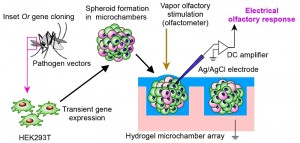Chemical vapor detection using insect olfactory receptor complex New means of developing cell-based odor sensors

Professor Shoji Takeuchi and former Project Lecturer Koji Sato at the Institute of Industrial Science, the University of Tokyo, have developed a bioinspired electrophysiology technique to record the vapor olfactory response of three-dimensional cell spheroids expressing insect olfactory receptor complexes.

© 2014 Koji Sato.
Schematic drawing of chemical vapor detection using insect OR complex. OR expressing spheroids were obtained by a culture of insect OR expression vector transfected cells in the microchamber. The microchamber was fabricated by photolithography. OR-expressing spheroids were loaded onto the surface of a hydrogel microchamber, and the extracellular field potential of the individual spheroid was recorded as the olfactory response.
Hedonic scale of odor is one of the standard indexes used to evaluate Quality of life (QOL). Olfaction also has important biological roles in insect pathogen vectors throughout their life history. Thus, evaluation of odorants in the environment are important aspects of social life and public health.
The olfactory receptors (OR) in the noses of dogs and other animals are sophisticated sensor elements for chemical vapors. Considerable effort has been expended to develop OR-based olfactory sensors. However, the detection of chemical vapors by reconstituted OR proteins has not yet been reported.
In this study, the research group expressed insect OR complexes in cell spheroids and arranged them in a hydrogel microchamber array. The spheroids showed olfactory responses to their ligand, which diffused from chemical vapors through the thin surface aqueous layer. Using the same technique, the olfactory responsiveness of a malaria vector mosquito OR were examined. The difference between in vivo and in vitro ligand response suggests that certain compounds in olfactory mucus or lymph are required to bring about the olfactory response.
This research clarifies the importance of the role of nasal mucus, which to date has received little attention, and provides a useful technique for application to public health and sensory physiology research.
Press release [PDF] (Japanese)
Paper
Shoji Takeuchi, Koji Sato,
“Chemical vapor detection using a reconstituted insect olfactory receptor complex” ,
Angewandte Chemie International Edition Online Edition: 2014/7/29 (Japan time), doi: 10.1002/anie.201404720.
Article link
Links
Institute of Industrial Science
Center for International Research on Integrative Biomedical Systems, Institute of Industrial Science






